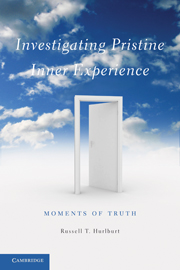Book contents
- Frontmatter
- Contents
- List of Figures and Tables
- Preface
- Acknowledgments
- 1 Moments of Truth
- 2 Fragmented Experience in Bulimia Nervosa
- 3 Apprehending Pristine Experience
- 4 Everyday Experience
- 5 Moments Are Essential
- 6 Experience in Tourette's Syndrome
- 7 The Moment (Not): Happy and Sad
- 8 Subjunctification
- 9 Before and After Experience? Adolescence and Old Age
- 10 Iteration Is Essential
- 11 Epistemological Q/A
- 12 A Consciousness Scientist as DES Subject
- 13 Pristine Experience (Not): Emotion and Schizophrenia
- 14 Multiple Autonomous Experience in a Virtuoso Musician
- 15 Unsymbolized Thinking
- 16 Sensory Awareness
- 17 The Radical Non-subjectivity of Pristine Experience
- 18 Diamonds versus Glass
- 19 Into the Floor: A Right-or-Wrong-Answer Natural Experiment
- 20 The Emergence of Salient Characteristics
- 21 Investigating Pristine Inner Experience
- Appendix: List of Constraints
- References
- Index
7 - The Moment (Not): Happy and Sad
Published online by Cambridge University Press: 05 June 2012
- Frontmatter
- Contents
- List of Figures and Tables
- Preface
- Acknowledgments
- 1 Moments of Truth
- 2 Fragmented Experience in Bulimia Nervosa
- 3 Apprehending Pristine Experience
- 4 Everyday Experience
- 5 Moments Are Essential
- 6 Experience in Tourette's Syndrome
- 7 The Moment (Not): Happy and Sad
- 8 Subjunctification
- 9 Before and After Experience? Adolescence and Old Age
- 10 Iteration Is Essential
- 11 Epistemological Q/A
- 12 A Consciousness Scientist as DES Subject
- 13 Pristine Experience (Not): Emotion and Schizophrenia
- 14 Multiple Autonomous Experience in a Virtuoso Musician
- 15 Unsymbolized Thinking
- 16 Sensory Awareness
- 17 The Radical Non-subjectivity of Pristine Experience
- 18 Diamonds versus Glass
- 19 Into the Floor: A Right-or-Wrong-Answer Natural Experiment
- 20 The Emergence of Salient Characteristics
- 21 Investigating Pristine Inner Experience
- Appendix: List of Constraints
- References
- Index
Summary
This chapter examines the co-determination of moments ↔ experience ↔ genuinely submitting to the constraints from the perspective of highlighting what is not a moment. Most of psychological science does not appreciate the inherent difficulty of recognizing the moment and therefore (as implied by the co-determination) does not appreciate the difficulty of recognizing experience.
CAN PEOPLE FEEL HAPPY AND SAD AT THE SAME TIME?
We begin by examining a study by Larsen, McGraw, and Cacioppo (2001) called “Can people feel happy and sad at the same time?” I choose this example because it is a well-done study by orthodox psychology standards, and because it deals with moments more carefully than do most orthodox psychology studies. However, I will show that despite this care, Larsen, McGraw, & Cacioppo (2001) do not define moments carefully enough to be considered to be genuinely submitting to the constraints that the study of moments of pristine experience requires.
My critique is aimed at orthodox psychology in general, not at Larsen and his colleagues (2001) in particular. My logic is: The Larsen et al. paper is an exemplar of very good orthodox psychology; that paper does not define moments carefully enough; therefore orthodox psychology's treatment of moments is not adequate for the genuine exploration of pristine experience.
Our concern is the way moments are used by Larsen, McGraw, and Cacioppo (2001).
- Type
- Chapter
- Information
- Investigating Pristine Inner ExperienceMoments of Truth, pp. 104 - 115Publisher: Cambridge University PressPrint publication year: 2011



